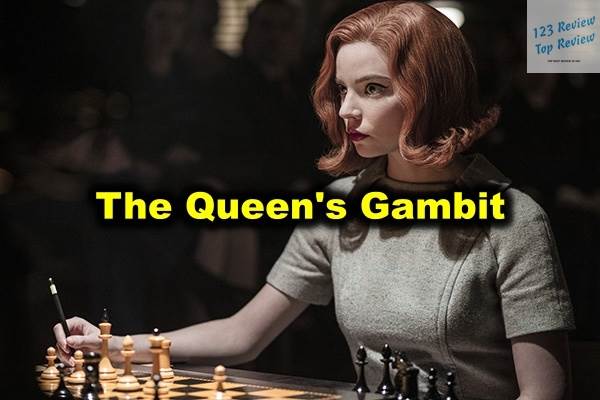“The Queen’s Gambit,” a Netflix miniseries that took the world by storm upon its release in 2020, stands as a masterclass in storytelling, character development, and visual artistry. Adapted from Walter Tevis’s 1983 novel of the same name, the series not only captivated a global audience with its intense and intricately portrayed chess matches but also offered a profound exploration of the human condition through the eyes of its prodigious protagonist, Beth Harmon.

In this article, 123 Review delves into every facet of the series, from its faithful adaptation of the novel to its far-reaching impact on popular culture, its exploration of complex themes, and its lasting legacy in both the entertainment industry and the world of chess.
Overview of the Series
Adaptation from Novel
“The Queen’s Gambit” is a remarkably faithful adaptation of Walter Tevis’s novel, preserving the essence of the story while amplifying its emotional and psychological depth through visual storytelling. The series traces the journey of Beth Harmon, an orphaned girl who discovers an extraordinary talent for chess while grappling with addiction and personal demons. The showrunners, led by Scott Frank, managed to capture the novel’s nuanced portrayal of Beth’s inner world, bringing her struggles and triumphs to life with an authenticity that resonates deeply with viewers. The adaptation succeeds in translating the novel’s introspective narrative into a visually dynamic experience, making it accessible to both chess enthusiasts and those unfamiliar with the game.
Reception and Impact on Pop Culture
Upon its release, “The Queen’s Gambit” became an instant cultural phenomenon, garnering widespread acclaim from critics and viewers alike. The series not only reintroduced chess to the mainstream but also influenced various aspects of popular culture, from fashion to social media trends. Beth Harmon’s 1960s-inspired wardrobe, characterized by chic, mod-style dresses and bold patterns, sparked a resurgence of interest in vintage fashion, with numerous fashion brands drawing inspiration from the show’s iconic looks. Chess sets saw an unprecedented surge in sales, and online chess platforms reported a dramatic increase in new users, with millions of people around the world inspired to learn and play the game. The show’s impact extended beyond the screen, with references to it appearing in music, art, and even other television series, cementing its status as a pop culture touchstone.
Main Themes
Talent and Dedication
At its core, “The Queen’s Gambit” is a story about talent and the relentless dedication required to transform that talent into mastery. Beth Harmon’s journey from a novice to a world-renowned chess grandmaster is a testament to the power of perseverance and the sacrifices that come with the pursuit of excellence. The series meticulously portrays the countless hours Beth spends studying chess, practicing moves, and honing her skills, highlighting the often-overlooked reality that even prodigies must work tirelessly to achieve greatness. Through Beth’s story, the series explores the intersection of natural talent and hard work, illustrating that true mastery is the result of both innate ability and unwavering commitment.
Addiction and Recovery
Beth Harmon’s struggle with addiction is a central and deeply resonant theme in “The Queen’s Gambit.” From a young age, Beth battles substance abuse, initially introduced to tranquilizers at the orphanage where she grows up. These pills, intended to keep the children docile, become a crutch for Beth, helping her to focus during chess matches but also leading her down a dangerous path of dependency. As the series progresses, Beth’s addiction escalates, with alcohol becoming another vice that threatens to derail her career and her life. The portrayal of addiction in the series is both realistic and empathetic, showing the destructive effects of substance abuse while also acknowledging the complex reasons behind Beth’s reliance on these substances. Her eventual recovery, marked by a conscious decision to reclaim control over her life, is depicted as a pivotal moment in her journey, illustrating the possibility of redemption and the strength required to overcome personal demons.
Gender Roles in Chess
Set in the 1960s, a time when the world of chess was overwhelmingly male-dominated, “The Queen’s Gambit” explores the challenges Beth faces as a woman trying to break into this exclusive club. The series deftly highlights the gender biases and stereotypes that Beth encounters, from being underestimated by her male opponents to facing skepticism from the chess community at large. Despite these obstacles, Beth’s success in the male-dominated sphere of competitive chess is a powerful statement about the breaking of gender barriers. Her victories are not just personal triumphs but also symbolic of a broader challenge to traditional gender roles, inspiring a new generation of women to pursue their passions in fields where they have historically been underrepresented.
Character Analysis
Beth Harmon: Prodigy and Complexity
Beth Harmon, brought to life with extraordinary depth by Anya Taylor-Joy, is a character of remarkable complexity. As a chess prodigy, Beth possesses an innate understanding of the game that sets her apart from her peers. However, her prodigious talent is accompanied by profound emotional and psychological struggles. Beth’s journey is marked by her quest for identity and belonging, as she navigates the pressures of fame, the loneliness of success, and the weight of her past traumas. Her character arc is one of self-discovery, as she learns to balance her need for independence with her desire for connection. The series portrays Beth not just as a chess genius but as a fully realized human being, whose vulnerabilities and strengths make her one of the most compelling protagonists in recent television history.
Supporting Characters: Influence on Beth
The supporting characters in “The Queen’s Gambit” play crucial roles in shaping Beth’s journey, each contributing to her development in unique ways. Mr. Shaibel, the janitor who introduces Beth to chess, is a pivotal figure in her early life, providing her with the foundation upon which she builds her career. His quiet encouragement and unwavering belief in her potential set the stage for her later successes. Jolene, Beth’s friend from the orphanage, represents a connection to her past and a source of support that remains constant even as Beth’s life changes dramatically. Other characters, such as Alma Wheatley, Beth’s adoptive mother, and Benny Watts, her chess rival and mentor, each leave a lasting impact on Beth, influencing her both on and off the chessboard. These relationships add depth to the narrative, showing how the people around Beth help shape her into the person and player she becomes.
Antagonists: Internal and External Conflicts
Beth’s journey is marked by a series of antagonists, both external and internal, that she must overcome to achieve her goals. Externally, Beth faces formidable opponents on the chessboard, each representing a different challenge to her skills and strategy. However, her most significant battles are internal, as she struggles with addiction, self-doubt, and the emotional scars of her past. These internal conflicts are portrayed with a level of nuance that adds depth to her character and the overall narrative. The series effectively juxtaposes Beth’s external victories with her internal struggles, creating a tension that drives the story forward and keeps viewers engaged.
Critical Acclaim
Awards and Nominations
“The Queen’s Gambit” achieved critical acclaim, earning numerous awards and nominations that solidified its place as one of the standout series of 2020. At the 73rd Primetime Emmy Awards, the series won 11 awards, including Outstanding Limited or Anthology Series, and received accolades for its direction, writing, and acting. Anya Taylor-Joy’s portrayal of Beth Harmon earned her a Golden Globe for Best Actress in a Miniseries or Television Film, among other honors. The show’s success at various awards ceremonies reflects its high-quality production values, compelling performances, and the powerful impact it had on audiences and critics alike.
Audience Reception and Feedback
The audience reception of “The Queen’s Gambit” was overwhelmingly positive, with viewers praising the series for its gripping storyline, strong character development, and stunning visuals. The series quickly became one of Netflix’s most-watched shows, with over 62 million households tuning in within the first 28 days of its release. Fans and critics alike were drawn to the show’s ability to make chess—a game often perceived as slow and cerebral—intensely dramatic and emotionally engaging. The series also sparked a wave of interest in chess among viewers of all ages, leading to a resurgence in the game’s popularity worldwide. Social media buzz, fan art, and discussions on platforms like Reddit further demonstrated the deep connection that viewers felt with the show, solidifying its place in television history.
Visual and Artistic Elements
Cinematography Techniques
The cinematography of “The Queen’s Gambit” is one of its most striking features, with each episode meticulously crafted to enhance the narrative’s emotional and psychological depth. Director of photography Steven Meizler employed a variety of techniques to bring the chess matches to life, using close-ups, overhead shots, and dynamic camera movements to capture the tension and strategy of the game. The visual representation of Beth’s mental processes during chess matches—such as the rapid movement of pieces on the ceiling of her room—is a particularly innovative approach, adding a surreal and almost magical quality to the storytelling. The use of lighting and color throughout the series further enhances the mood, with warm, muted tones reflecting Beth’s internal struggles and the changing atmospheres of the various settings.
Set and Costume Design
The set and costume design in “The Queen’s Gambit” are integral to the series’ immersive 1960s aesthetic. Production designer Uli Hanisch and costume designer Gabriele Binder created a world that feels both authentic and visually captivating, with each location and outfit carefully chosen to reflect the characters and the era. Beth’s wardrobe, in particular, serves as a visual narrative of her personal growth, with her clothing evolving from the simple, practical dresses of her orphanage days to the sophisticated, high-fashion ensembles she wears as a world-renowned chess player. The sets, from the austere orphanage to the opulent hotels of international chess tournaments, are rich in detail, providing a vivid backdrop to the story and contributing to the overall atmosphere of the series.
Legacy of The Queen’s Gambit
Influence on the Chess World
“The Queen’s Gambit” has had a profound and lasting impact on the world of chess, reigniting interest in the game and inspiring a new generation of players. The series’ portrayal of chess as a complex and thrilling sport, combined with its focus on a strong, relatable female protagonist, has drawn more women and girls to the game, challenging the traditional gender dynamics of the chess world. Chess clubs and online platforms have reported a significant increase in membership and participation, with many attributing this surge directly to the influence of the series. Moreover, the series has sparked discussions about the representation of women in chess, leading to initiatives aimed at promoting gender equality within the sport. The legacy of “The Queen’s Gambit” in the chess community is undeniable, with its influence likely to be felt for years to come.
Impact on Television and Media
In addition to its influence on chess, “The Queen’s Gambit” has left a lasting mark on the television and media landscape. The series’ success has demonstrated the potential for character-driven, intellectually stimulating narratives to captivate a broad audience, challenging the notion that television must cater to the lowest common denominator to be successful. The show’s blend of historical accuracy, psychological depth, and visual artistry has set a new standard for limited series, inspiring other creators to pursue ambitious, high-quality projects. Furthermore, “The Queen’s Gambit” has contributed to the ongoing evolution of how women are portrayed in media, with Beth Harmon standing as a complex, multifaceted female protagonist who defies traditional stereotypes. The series’ impact on television storytelling and its role in shaping future narratives cannot be overstated.
Conclusion
“The Queen’s Gambit” is a tour de force of television storytelling, offering a compelling narrative, richly developed characters, and a visually stunning portrayal of the world of chess. Its exploration of themes such as talent, addiction, and gender roles, combined with its cultural impact and critical acclaim, has cemented its place as one of the most significant series of the 21st century. As both a cultural phenomenon and a masterclass in filmmaking, “The Queen’s Gambit” will be remembered not just for its portrayal of chess but for its profound and enduring impact on popular culture and the world of television. Whether you are a chess enthusiast or simply a lover of great storytelling, “The Queen’s Gambit” is a series that will leave a lasting impression, continuing to inspire and entertain for years to come.





